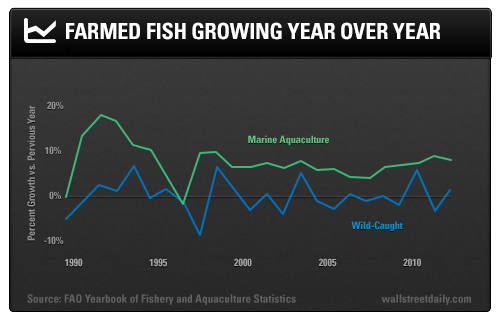On August 17, the privately owned agriculture giant Cargills PLC (CM:CARG) made the second-biggest acquisition in its 150-year history.
But it didn’t purchase in the grain, meat, poultry, or any of the other traditionally lucrative sectors.
Nope. Cargill is betting that the next hot growth area in farming will come from the sea.
The company plunked down about $1.5 billion for the Norwegian salmon feed producer, EWOS AS. In July, Cargill announced another smaller, $30-million deal with Naturisa to build a shrimp feed facility in Ecuador.
It seems the world’s largest grain trader has suddenly transformed itself into one of the three top aqua-feed producers in the world.
Hot Fish!
The reason behind Cargill’s moves is obvious. Fish farming has quietly become a big business. In fact, farmed fish production exceeded global beef output in volume back in 2010.
Leading the way is salmon. Over the past five years, production of farmed salmon worldwide has soared by a third to 2.5 million metric tons. Much of this growth occurred in China. The country is believed to produce about 62% of the world’s farmed salmon.
More salmon raised means more feed is needed. Demand for salmon feed is expected to climb by 4% to 5% this year and next. That’s a faster clip than any other animal protein, according to Rabobank.
And Cargill is hardly alone in its move into aquaculture and salmon.
In 2014, Japan’s Mitsubishi Corp. (TOKYO:8058) bought Norwegian fishery Cermaq ASA for about $1.4 billion. That made it the world’s number two salmon farmer.
The timing of both purchases looks to be right on the money.
Last year was a key milestone for the aquaculture industry. It was the first time that the consumption of farmed fish globally exceeded that of wild-caught fish. Just three decades ago, farmed fish accounted for a mere 11% of the amount of fish consumed.

That growth will continue to accelerate. By 2030, the World Bank estimates that 62% of all fish eaten will be farm-raised. And since 1980, farmed fish production has grown a spectacular 13-fold.
But it’s not enough. A study from the World Resources Institute said that the world, with more than nine billion people by 2050, will need farmed fish production to more than double by then.
Much of that demand for salmon will come from the world’s growing middle class. The Brookings Institution thinks the middle class will grow by 50% to 3.8 billion people in just 10 years.
The Water Jump
In order to meet that demand though, the industry must overcome some hurdles.
One major stumbling block for the industry is the problem of sea lice infestation. The parasite is found in much larger concentrations when fish are penned, as with farming. And it can spread to nearby wild populations.
The lice can weaken the host fish’s immune system, too, making it more susceptible to disease.
In the past, medicines were added to the fish feed, but the lice became resistant. Other measures like chemicals or pesticides in the water led directly to pollution of the surrounding waters.
Now the industry is trying out cleaner fish, such as wrasse and lumpsuckers, to take care of the lice. These fish naturally feed on the parasites.
“Lice lasers” are also being introduced.
Aquaculture Investment
One company leading the way in such preventative practices is the world’s largest producer of farmed salmon and trout, Marine Harvest ASA (OSLO:MHG).
The company joined the Aquaculture Stewardship Council, which is championed by the World Wildlife Fund.
From a business standpoint, it’s the biggest consolidator in the industry. And it’s adding to its operations both in its home base of Norway as well as Chile. The added capacity allowed Marine Harvest to produce 27% of the world’s farmed salmon last year.
And there’s a nice kicker here for income-oriented investors. The current yield on Marine Harvest is 5.5%. But their dividend isn’t fixed. Its floats, depending on how well the company does.
There’s probably no better pure play in aquaculture than Marine Harvest.
